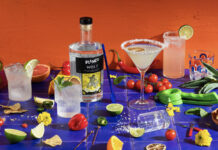
Distilled spirits are — as we are often reminded — an agricultural product. But most distillers are several steps removed from the fields where their grains actually grow.
Frey Ranch Distillery is different. Long before they launched their whiskey company, co-founders Colby and Ashley Frey had been carrying on the long-standing Frey family tradition of growing wheat, barley, corn, and rye in Fallon, Nevada, about 70 miles east of Reno. Even today, as their grain-to-glass whiskeys garner accolades across the country, the husband-and-wife team continues to farm about 2,500 acres in western Nevada from a property Colby’s family has lived on since the 1850s.
The Freys started developing the recipes that would become their award-winning whiskeys in 2006 under a federal experimental license, but they weren’t able to actually sell anything until 2013, when they helped get Nevada’s first craft distilling laws on the books. Today, Frey Ranch Distillery isn’t just the state’s largest producer; it’s also one of the only distilleries in the country that grows every kernel of the grain it uses. Factor in the on-site cooperage and malting house, and there are few other opportunities anywhere else in the world to experience the flavors of a single place so clearly in a whiskey.
As Frey Ranch looks toward celebrating its 10th anniversary, Colby shared his experience founding one of the nation’s largest farm distilleries with Distiller, including how distilling fits with the farm’s larger operations, the pleasures of experimentation, and the surprising new use they found for an old silo.
What kinds of grains do you grow for your whiskey?
My family started farming here in 1854. We’d always grown some type of wheat, rye, barley, and corn all of that time. Often they were rotation crops for alfalfa. We’d take soil tests, because certain grains grow better in certain types of soils, and we’d play the market in different years, so it was always a variety of one to all four of them. We’ve never bought any grain or sourced any bulk whiskey.

How is making whiskey like grain farming — and how is it different?
Obviously, mother nature plays a huge part on the farming side. We can distill year-round, because we can store the grain over long periods of time. But we also malt all the different types of grains — we make traditional malted barley but we’ve also malted corn, wheat, and rye. When you malt any grain, you’re essentially germinating it, so it’s very similar to how it will grow on the farm.
Corn, for instance, we don’t plant until May, because corn needs heat. Our wheat, rye, barley, and oats are all winter crops. We plant them in fall, they grow slowly all winter, and then they grow fast in the spring. Rye will grow at any temperature above 32°F. In the malting drum, we actually have to turn on the AC and really cool the rye, because it’ll take off. Whereas corn, we need to turn on the heater and actually add heat to the malting drum. And a lot of people might not realize that unless they’re growing those crops themselves.
From those four grains, you can make a lot of different whiskeys. What’s especially popular? And what’s your favorite?
Our production is 80% bourbon, which includes things like the Farm Strength and Single Barrels, and a lot of other things. About 15% is rye, and we also have a Single Barrel in that and our flagship Bottled-in-Bond rye. And then 5% is our fun stuff. Our goal from the beginning was to really showcase the grains we grow on the farm. That was one of the big inspirations behind the distillery, to take our grain and make something. So it’s 5% of the production and 95% of the fun.
We distill each grain by itself, 100% of each variety, plus malted and unmalted barley and oat. We also have a smoked single malt we just released and a smoked oat and rye we haven’t released yet. We have five-grain bourbons with oats, four grains with wheat replaced with oats, and one where we replaced the rye with oats. We have a quad malt, which is wheat, rye, barley, and corn, all malted, in the same ratios as the flagship bourbon. Everything’s the same except all the grains are malted, so you can taste what malting does. We had a 100% malted corn. We actually got TTB approval to call it 100% single malt corn bourbon, which is a totally crazy thing to think about. It’s fun for me to play around with different mash bills. A lot of distillers might do secondary aging, but for us, that would mask the flavor. We did a small amount of that, but not very much, because that’s not who we are. We’re farmers and we want to showcase the grain and show off the grain.

You just released your first estate-smoked American single malt. What’s that all about?
We made our own smoker! We took a silo, a big silo, and filled it with like 25 tons of grain. Then instead of smoking from the bottom up through the grain, we actually put a chimney from a wood burning stove into the top and a little fan at the bottom that would suck the grain out the bottom. We did some homemade peat with decomposed corn stalks, and also bought a little bit of Scottish peat blocks to supplement it. It was really fun to take our grains and our homemade peat and make something out of it.
Who has been an important help to you along the way?
Our team has been great. Russell, our master distiller, has been really instrumental. He’s also a certified crop consultant, so he really understands farming and distilling. I think there’s often a big disconnect between farmers and distillers. Distillers don’t always know how to articulate what they need to the farmer, and vice versa. By bridging that gap, we think we can get the best quality.
Just the distilling world in general has been extremely helpful. Other producers are amazing. We can go and talk to a lot of master distillers and other people who are producing whiskey, and they are an open book. While the marketing and the sales people are butting heads on the street, the whole production side of distilling has been so helpful as a whole.








